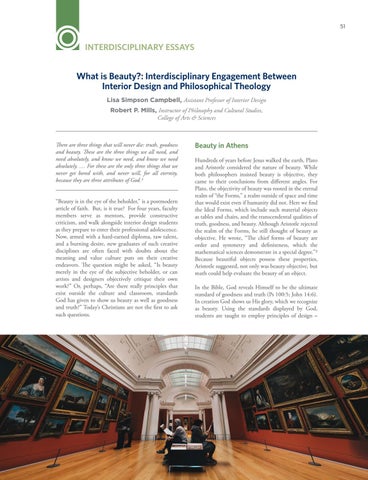51
INTERDISCIPLINARY ESSAYS
What is Beauty?: Interdisciplinary Engagement Between Interior Design and Philosophical Theology Lisa Simpson Campbell, Assistant Professor of Interior Design Robert P. Mills, Instructor of Philosophy and Cultural Studies, College of Arts & Sciences
There are three things that will never die: truth, goodness and beauty. These are the three things we all need, and need absolutely, and know we need, and know we need absolutely. … For these are the only three things that we never get bored with, and never will, for all eternity, because they are three attributes of God.1 “Beauty is in the eye of the beholder,” is a postmodern article of faith. But, is it true? For four years, faculty members serve as mentors, provide constructive criticism, and walk alongside interior design students as they prepare to enter their professional adolescence. Now, armed with a hard-earned diploma, raw talent, and a burning desire, new graduates of such creative disciplines are often faced with doubts about the meaning and value culture puts on their creative endeavors. The question might be asked, “Is beauty merely in the eye of the subjective beholder, or can artists and designers objectively critique their own work?” Or, perhaps, “Are there really principles that exist outside the culture and classroom, standards God has given to show us beauty as well as goodness and truth?” Today’s Christians are not the first to ask such questions.
Beauty in Athens Hundreds of years before Jesus walked the earth, Plato and Aristotle considered the nature of beauty. While both philosophers insisted beauty is objective, they came to their conclusions from different angles. For Plato, the objectivity of beauty was rooted in the eternal realm of “the Forms,” a realm outside of space and time that would exist even if humanity did not. Here we find the Ideal Forms, which include such material objects as tables and chairs, and the transcendental qualities of truth, goodness, and beauty. Although Aristotle rejected the realm of the Forms, he still thought of beauty as objective. He wrote, “The chief forms of beauty are order and symmetry and definiteness, which the mathematical sciences demonstrate in a special degree.”2 Because beautiful objects possess these properties, Aristotle suggested, not only was beauty objective, but math could help evaluate the beauty of an object. In the Bible, God reveals Himself to be the ultimate standard of goodness and truth (Ps 100:5; John 14:6). In creation God shows us His glory, which we recognize as beauty. Using the standards displayed by God, students are taught to employ principles of design –
